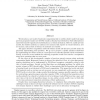Free Online Productivity Tools
i2Speak
i2Symbol
i2OCR
iTex2Img
iWeb2Print
iWeb2Shot
i2Type
iPdf2Split
iPdf2Merge
i2Bopomofo
i2Arabic
i2Style
i2Image
i2PDF
iLatex2Rtf
Sci2ools
JCB
1998
1998
A Sticker-Based Model for DNA Computation
We introduce a new model of molecular computation that we call the sticker model. Like many previous proposals it makes use of DNA strands as the physical substrate in which information is represented and of separation by hybridization as a central mechanism. However, unlike previous models, the stickers model has a random access memory that requires no strand extension, uses no enzymes, and
at least in theory
its materials are reusable. The paper describes computation under the stickers model and discusses possible means for physically implementing each operation. We go on to propose a speci c machine architecture for implementing the stickers model as a microprocessor-controlled parallel robotic workstation. Finally, we discuss several methods for achieving acceptable overall error rates for a computation using basic operations that are error prone. In the course of this development a number of previous general concerns about molecular computation Smith, Hartmanis, Letters to Scie...
| Added | 22 Dec 2010 |
| Updated | 22 Dec 2010 |
| Type | Journal |
| Year | 1998 |
| Where | JCB |
| Authors | Sam T. Roweis, Erik Winfree, Richard Burgoyne, Nickolas V. Chelyapov, Myron F. Goodman, Paul W. K. Rothemund, Leonard M. Adleman |
Comments (0)

